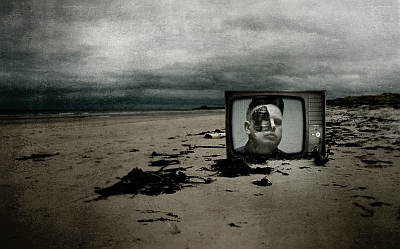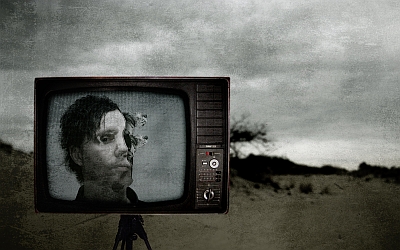
Interview with
Carsten Jacek and Tom Lesczenski of [:SITD:]
The new [:SITD:] album ‘Rot’ is just around the corner with its release date slated for 23ed October 2009. A new album also is always a great opportunity and we grabbed the chance to have us answered some questions about the new record by Tom and Carsten which brought to light many interesting details.
Reflections of Darkness (RoD): How much time passed after finishing the last album ‘Bestie:Mensch’ until new ideas took shape?
Tom: This is a continuous process. Actually, we’re constantly working on new songs. As soon as we have any idea, we record it as demo or lyric draft. After returning from our North American tour end of 2008, we started specifically working out the collected ideas.
RoD: Was there a fixed point in time where a specific topic, a concept emerged or was it already set before you started to work on the new album?
Tom: Before we started working in the studio we set ourselves specific standards we never let out of sight during the creational process of the album. We wanted to make an album, sounding much harder and more direct compared to its predecessor. To achieve this specific, genuine immediacy and authenticity we focused on the bare essentials and removed needless dead freight. Furthermore, we upped the BPM count significantly. One basic concern of ours also was to create a certain roughness production-wise, not heard from us in such consequence since ‘Snuff Machinery’ and ‘Laughingstock’.
RoD: The title of the new album ‘Rot’ already opens the doors for speculations of any kind, for it’s not having just the simple meaning of a colour to mankind. You can also associate it with rage and aggression, or in religion it is connected to the Holy Ghost and the blood of martyrs. But what’s the meaning of this colour in the context of the album?
Carsten: That’s right! ‘Rot’ is a strongly accentuated title which is expressing just what we’re connecting with [:SITD:]. ‘Rot’ (Red) stands for warmth and energy, joy and passion, but also for aggression, rage and a revolutionary fighting spirit. Everything we do, we’re pursuing with all our energy, joy and passion which is
 something we also want to convey to our listeners. Furthermore, ‘Rot’ is the traditional colour of the labour movement we can completely identify with as children of the German Ruhr area. The colour stands for our origin and roots. Furthermore, ‘rot’ is THE signal and warning colour. This, in turn, can be adapted on our songs, which you can interpret as wake-up calls with which we want to address social injustices in society.
something we also want to convey to our listeners. Furthermore, ‘Rot’ is the traditional colour of the labour movement we can completely identify with as children of the German Ruhr area. The colour stands for our origin and roots. Furthermore, ‘rot’ is THE signal and warning colour. This, in turn, can be adapted on our songs, which you can interpret as wake-up calls with which we want to address social injustices in society. Let’s take ‘Frontal’ as an example. The song’s main topic is the growing number of intrusions of the state into the privacy of its citizens, often covered as counter-terrorism. Through data preservation of phone and internet data it is possible for the state in Germany since 2008 to trace back who was in contact with whom within the last 6 months. With the help of this data collected from all citizens, they can now create movement profiles, trace back business contacts, and identify private relationships. Also it is possible now to draw conclusions about personal interests and the private situation of the communicating person. Other measures like eavesdropping operations or the possible implementation of a Trojan program financed by the German government are another cause for concern.
We’re always wondering about how passive big parts of the German citizens react about this; or better condone it. We won’t look away and will express our point of view and so, we’ve come full circle with the album title again, because we do what we do with lots of rage in our guts and a revolutionary fighting spirit, so the title is important to the album in more than one way.
RoD: Looking at the cover artwork of the new album I couldn’t help but thinking of seeing gun barrels reaching out of the water. Is that really the case or just a result of my vivid imagination?
Carsten: The good thing about an artistic depiction is that everyone has different feelings and associations when looking at a picture. There’s no universal explanation neither for a song nor for an artwork. As an artist you can express your intentions with certain depictions, but that is not to say that other renditions are wrong. It’s quite the contrary: Art is playing with these open spaces, so does music and also language. There’s always more than just one truth. What you’re getting out of it for yourself all lies in the eye of the beholder. In case of the cover we wouldn’t feel comfortable with limiting the imagination of the beholder by delivering our own view. Your interpretation surely is one possible approach.
RoD: Who was responsible for the artwork this time?
Carsten: On this one like on all our previous releases we have worked together with User.dx.
RoD: Upon hearing the album title for the first time, I expected a much more radical approach to the design of the artwork, due to the associations with the colour. But now you get to see this relatively calm water surface with the “Gun Barrels” and the red flag. One of my first thoughts regarding this were “Nothing’s always what it seems to be” or something that fits it even better “Silent waters are deep”. How did this tableau ultimately come about?
 Carsten: That’s been a deliberate decision. We didn’t want anything bold, but wanted to create an open room for interpretations. We wanted something that is beyond realism. The red flag on the water surface admittedly is a surreal scenario. It was our goal to explore the unreal, the dreamy, as well as the depths of the unconscious and to expand the field of experience limited by human logic with the fantastic and the absurd. That’s why we chose this surrealistic approach.
Carsten: That’s been a deliberate decision. We didn’t want anything bold, but wanted to create an open room for interpretations. We wanted something that is beyond realism. The red flag on the water surface admittedly is a surreal scenario. It was our goal to explore the unreal, the dreamy, as well as the depths of the unconscious and to expand the field of experience limited by human logic with the fantastic and the absurd. That’s why we chose this surrealistic approach. RoD: Now, let’s continue with some songs from the new album, starting with the intro ‘The Insanity of Normality’. Upon listening to this track you get the feeling of being dragged into an abyss, virtually under the water surface to link back to the artwork again. Was that the actual intention of the song?
Tom: A very good, apt picture. This is exactly what we’ve intended. To stick with this picture: The song creates an undertow slowly dragging you under the water surface. It is started by inner conflicts and repressed emotions and the water has a cleansing effect. It’s no coincidence ‘The Insanity of Normality’ is introducing the song ‘Catharsis’. The word “Catharsis” is Greek and stands for “Cleansing”. Psychology suggests that living out inner conflicts and repressed emotions leads to a reduction of the conflicts and emotions. The film “American Psycho” was a main source of inspiration for this by the way.
RoD: On a related note, did you get any standards by Carsten regarding this and simply transformed them into music?
Tom: We’re giving each other suggestions regarding music and lyrics, but there are no mandatory standards limiting our creativity. There’s a constant exchange. It’s a fluent, creative process! Most important is that we can identify with the end result completely.
RoD: The following lines in the title song “Siehst du den Himmel nicht / Er hält was er verspricht“ and “Siehst du den Himmel nicht / Sein Rot zeigt dir das Licht“ still remain mystery to me even after long and careful consideration. I just can’t figure out their meaning, which is undoubtedly an important one for the song. Maybe you can shed some light on the affair Carsten?
Carsten: The red colour of the skies described here are a metaphor for the positive associations with the colour “Red” like warmth, energy and love. In our darkest ours we often oversee the positive signals and are not susceptible to them. ‘Rot’ is meant for all those standing on the edge not knowing how to move on. ‘Rot’ is a positive signal, a rescuing hand meant to keep us away from the abyss. We’re purposely utilizing a pictorial language to make it possible for the listeners to find themselves within the song.
RoD: ‘Stigmata of Jesus’ for me is an incredible, visually stunning track. You can literally see the scenery of the crucified, suffering creature. More than before, the music and lyrics make up a unity. Why did it become a slow, atmospheric and also experimental song rather than a club-committed beat monster, and did Carsten’s lyrics induce the entirely different sonic outfit and wouldn’t allow a different musical interpretation?
Tom: In this case, the lyrics were created after the music. We basically wanted the album to have a high degree of club compatibility, but of course it’s also important to constantly re-invent yourself and to explore new musical grounds for yourself. We approached this song with the mindset that it wouldn’t necessarily have to become a song with vocals. The wish to try out something experimental was central with this song and so the creeping, dark and threatening sound came about. Once, we opened ourselves to the whole thing it instantly created images in our minds and one day Carsten came up with a fitting idea for the lyrics, and the instrumental became a song with vocals. That’s why it’s making us all the more happy you feel lyrics and music as being a unity.
RoD: Do the lyrics really describe THE crucifixion or is it serving as metaphor for something entirely different I’ve just not seen as yet?

Carsten: Yes, it’s describing a crucifixion scenario, but from the point of view of a “Stigmatized” person who physically feels the sorrows of Jesus and is mentally going through them as well. Some cases report that the crucifixion wounds of Jesus appear on living human’s bodies and that these open wounds wouldn’t heal for years just like they wouldn’t become infected. There are reports about a blood flow against gravity. Of course you couldn’t describe something like that medically. Therefore, are in dispute with theology, partly classifying “Stigmatization” as wonder. The first documented case of stigmatization is the one of Franz of Assisi (1181/82 - 1226).
RoD: When I read the title ‘Zodiac’ in the tracklist, I instantly had to think of the still unidentified serial killer who was up to mischief in the1960s and 70s in America. One of his letters also contained the words “My Name is…” re-appearing in the lyrics. Just a coincidence or intentional?
Carsten: It was intentional. We engaged ourselves with the phenomenon of the “Zodiac” killer. Besides movies we studied all available sources on the internet. Amongst them we found photographs of the original letters of the killer whose identity couldn’t be proven beyond doubt until today. The bizarre letters coded with symbols and signs, the killer sent the police and local press served us as an important source of inspiration. Thus, corresponding fragments can be found in the lyrics as well.
RoD: Musically, this song’s orchestration is almost clinically cold and goes without a concise melody contained in so many of your songs. Why was it different this time? Why did you need that song to sound just like this?
Tom: The break-beat-laden orchestration isn’t a typical thing for us, no doubt about that. On the album we chose for a synergy effect of elements standing for a progression of the band, but building up on well-tried elements on the other hand. ‘Zodiac’ is definitely standing for the exploration of new musical territory. We’re already curious how the song will hit with our audience.
RoD: ‘Redemption’ is one of two songs sung by Tom, and an incredible goose bump track by the way. Why is it one of the songs you’re lending your voice Tom? I guess there’s a specific reason for that is there?
Tom: We’re happy you feel that way. For me, it’s always important to have an emotional link to the songs I sing. This is the case with ‘Redemption’ and the album closer ‘Destination’.
Carsten: ‘Redemption’ is about the loss of a loved person. We were under the impression of the amok run in Winnenden when we put ourselves into the situation of the grieving relatives. The events touched us deeply, so that we had to do something of this following an inner feeling. As we already dealt with the topic from the offender’s perspective on ‘Laughingstock’, with reference to the amok runs in Littleton and Erfurt, we wanted to approach the topic from a different side this time and that’s how ‘Redemption’ came about. Actually it wasn’t our intention to reveal the complete background; it’s less about the deed itself, but more about the general feeling of grief and loss. But maybe it’s also important in order to understand that no brachial song could come of this, but a song that’s creating goose bumps and which just sounds as emotional as it is.
RoD: Now, let’s talk a bit about the bonus disc of the limited edition where the opener of the album is once more included, but this time as a full song. When did you come up with the idea of making it a full track?
 Tom: There are songs not letting go of you and ‘The Insanity of Normality’ was such a song. Many times instrumentals won’t receive as much estimation as a song with vocals. This is actually too bad, because the same heart’s blood and passion went into it. In case of ‘The Insanity of Normality’ we still had so many ideas after finishing the intro that it would ultimately become the [Final} version which has found its place on the bonus CD.
Tom: There are songs not letting go of you and ‘The Insanity of Normality’ was such a song. Many times instrumentals won’t receive as much estimation as a song with vocals. This is actually too bad, because the same heart’s blood and passion went into it. In case of ‘The Insanity of Normality’ we still had so many ideas after finishing the intro that it would ultimately become the [Final} version which has found its place on the bonus CD. RoD: My personal highlight on the CD is ‘Heldenhaft’, the closing song of the last album, but this time with beautiful vocals by a certain OTHURA. How did you find her and how did it come to the song being placed on the bonus CD eventually?
Tom: OTHURA is a very talented artist who worked for herself thus far without greater public attention. She sent us a link to a self-created video of ‘Heroic’. She would write lyrics to the song off the ‘Bestie:Mensch’ album and add vocals to it. We loved her voice right away and quickly came up with the idea of doing something together and release it. The only problem was that we wanted only new songs to come on the album. Another thing that wouldn’t fit into the concept was her lyrics. They were perfectly crafted but we were missing the reference we had in our minds to this instrumental piece and so we decided to rename ‘Heroic’ into ‘Heldenhaft’ and to write own German lyrics for it. The idea and the lyrics met with positive feedback on her side, so we invited her into our studio to make the idea reality. That’s how the song eventually found its way on the bonus CD.
RoD: New tour dates are already confirmed as we speak. Have you planned anything special for the live shows?
Carsten: We’re so looking forward this tour. After the long studio work there’s nothing better than finally being on stage again to present the new songs live and to share these moments with our audience. The interaction with our audience is the most important thing for us. The tour starts on 30th October 2009 in Amstelveen in the Netherlands and will also lead us to Switzerland and England besides Germany.
Tom: Currently, we’re giving our older songs a sonic update, so besides the new songs of ‘Rot’ there will be special live versions of old “Classics” as well. We’re very happy we could get both REAPER and AMNISTIA as support for the tour as well, so there’s an ample supply with electronic music. By the way, any news about the tour and all dates can be found on our revamped websites http://www.sitd.de/, http://www.myspace.com/xsitdx, as well as on our fan page http://www.sitd-fan-machinery.com/
RoD: Anything you’d like to add?
Tom: No, everything’s said. Many thanks for the interesting questions. It was much fun for us and of course many thanks to all the readers of Reflections of Darkness for their interest. We see you on tour.
RoD: That’s it. Thanks for taking the time to answer all these questions and good luck with the new album.
Carsten: You’re welcome. Many thanks!
Pictures by Silke Jochum, Picture post-processing by User.dx
{jos_sb_discuss:21}




